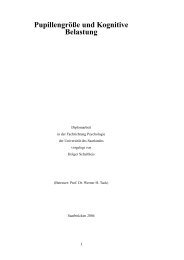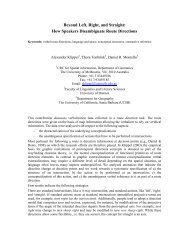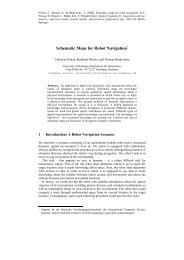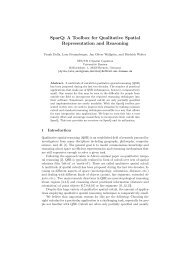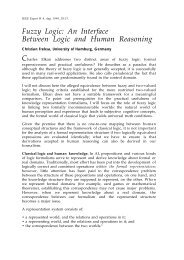Soar Tutorial - the Cognitive Systems Group
Soar Tutorial - the Cognitive Systems Group
Soar Tutorial - the Cognitive Systems Group
Create successful ePaper yourself
Turn your PDF publications into a flip-book with our unique Google optimized e-Paper software.
10<br />
2.5 Working Memory<br />
Working memory contains all of a <strong>Soar</strong> agent’s dynamic information about its world and its internal<br />
reasoning. It contains sensor data, intermediate calculations, current operators and goals. In <strong>Soar</strong>, all of<br />
working memory is organized as graph structures in states. Thus, every working memory element is<br />
connected directly or indirectly to a state symbol. For <strong>the</strong> first agents you will build, <strong>the</strong>re will be a single<br />
state. Below is a simple example of what <strong>the</strong> structure of working memory might be like if <strong>the</strong> agent were<br />
representing that <strong>the</strong>re were two blocks, one on top of <strong>the</strong> o<strong>the</strong>r, which is <strong>the</strong>n on a table as shown in <strong>the</strong><br />
figure below.<br />
A<br />
B<br />
State identifier<br />
Attribute<br />
Value<br />
Below is a graphic picture of <strong>the</strong> working memory structures that <strong>Soar</strong> creates automatically for every<br />
agent – so although not shown in <strong>the</strong> above figure, S1 would have <strong>the</strong>se additional structures.<br />
nil<br />
State identifier<br />
Attributes<br />
Value<br />
As a graph, <strong>the</strong>re are nodes (or vertices) and links (or edges). The nodes, such as S1, B1, B2, A, and<br />
blue, are connected by links, such as block, table, name, color, and superstate. <strong>Soar</strong> has<br />
two kinds of nodes: identifiers and constants. The nodes that can have links emanating from <strong>the</strong>m (<strong>the</strong>y<br />
are non-terminal nodes), such as S1 and B1, are called identifiers, while <strong>the</strong> o<strong>the</strong>rs (<strong>the</strong>y are terminal<br />
nodes), such as state, blue, block, and nil, are called constants.<br />
In <strong>the</strong> example above, S1 is <strong>the</strong> identifier for <strong>the</strong> state. All of <strong>the</strong> identifiers symbols are created<br />
automatically by <strong>Soar</strong> and consist of a single letter followed by a number. Although I2 and I3 in <strong>the</strong><br />
lower figure do not have any links emanating from <strong>the</strong>m, <strong>the</strong>y are identifiers and can have additional<br />
substructures added later. In contrast, <strong>the</strong> symbol state is not an identifier and cannot have links<br />
emanating from it. The links are called attributes in <strong>Soar</strong> and are prefaced by a “^”. Only identifiers have<br />
attributes. In <strong>the</strong> bottom figure, S1 has three attributes: superstate, io, and type. I1 has two:<br />
outputlink and inputlink.<br />
<strong>Soar</strong> <strong>Tutorial</strong><br />
^block<br />
S1<br />
^block<br />
^table<br />
B1<br />
^ontop<br />
B2<br />
^name<br />
^color<br />
^type<br />
^name<br />
^color<br />
^type<br />
^ontop<br />
T1<br />
^superstate<br />
I2<br />
^io<br />
^outputlink<br />
S1 I1<br />
^inputlink<br />
I3<br />
^type<br />
state<br />
^name<br />
^color<br />
^type<br />
A<br />
blue<br />
block<br />
B<br />
yellow<br />
block<br />
Table<br />
gray<br />
table



